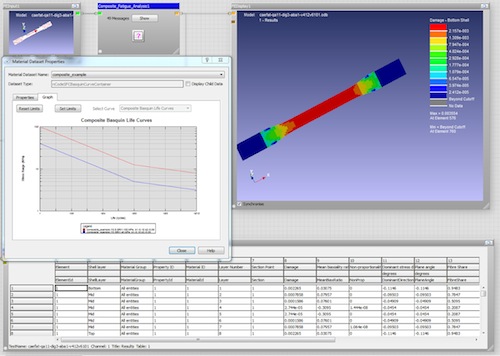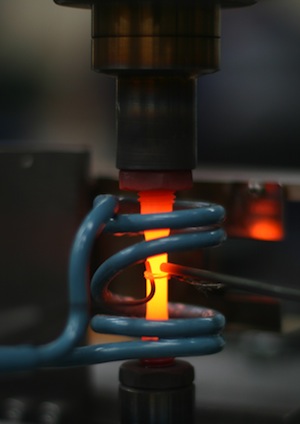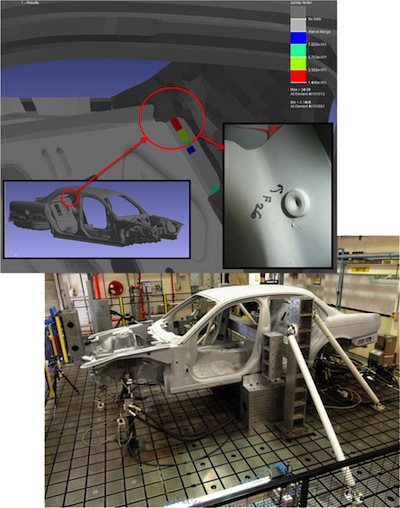Tools for Fatigue Analysis Enhanced
Version 8 of nCode DesignLife 8 offers new technologies for thermo-mechanical fatigue, short fiber composites, and adhesive bonds.
February 22, 2012
By DE Editors
HBM Inc. (Southfield, MI), the brand of durability, test, and analysis products from the HBM subsidiary of instrumentation and controls company Spectris plc, has announced the release of version 8 of its nCode DesignLife suite of fatigue analysis applications. The company reports that key technologies introduced in version 8 address thermo-mechanical fatigue, short fiber composite fatigue analysis, and adhesive bonds for vehicle structures. Additionally, nCode DesignLife 8 is said to deliver “substantial improvements” in overall performance and calculation speed.

Fatigue of composites in nCode DesignLife are available as a result of
collaboration with e-Xstream engineering, provider of the DIGIMAT material
modeling platform.
nCode DesignLife is designed to provide fatigue life and fatigue hotspot prediction analysis using finite element (FE) results produced by such systems as Abaqus, ANSYS, LS-DYNA, NASTRAN, PAM-CRASH, and RADIOSS. Core functionality includes a virtual strain gauge that enables you to correlate test with FE results; a Schedule Create feature for building and processing multiple cases that model a duty cycle; a materials manager; and Python scripting for extending analysis capabilities.
 nCode DesignLife 8 has new technology for high-temperature durability simulations. |
nCode DesignLife also provides a fracture mechanics capability said to use industry-standard methodologies for specified locations on an FE model. Built-in crack growth laws include NASGRO, Forman, Paris, and Walker. Users have the option of selecting stress intensity factors from a supplied library of geometries or from their customized supply. nCode DesignLife comes with GlyphWorks Fundamentals, which provides basic data manipulation, analysis, and visualization functionalities. (GlyphWorks Fundamentals is the core component of the company’s GlyphWorks data processing system for engineering test data analysis.) Analysis results can be output to Abaqus, Hypermesh, CSV, and PATRAN among other formats.
HBM says that it leveraged its experience with industry partners to provide commercial users of nCode DesignLife 8 a cost-effective toolset for solving real-world thermo-mechanical fatigue design problems. Version 8 works by using stress and temperature results from your FE system to provide durability simulations for estimating component life in extreme operating conditions. Methods Implemented include Larson-Miller creep and Chaboche for combined creep and fatigue. Optionally, users can perform creep calculations using time histories of stress without an FE model. Required materials data are available from a materials testing service at the developer’s ISO9001-certified laboratory.
For predicting the fatigue of composite materials, nCode DesignLife 8 incorporates new methods resulting from a collaboration between HBM and e-Xstream engineering, the Belgium-based developer of the DIGIMAT material modeling platform. For version 8, DesignLife focuses on engineering plastics, such the short fiber polymers commonly used in the automotive industry. DIGIMAT is said to determine the appropriate material parameters for a complete component, data which can then be coupled with an FE analysis. nCode DesignLife combines the calculated stresses together with specific fatigue properties to predict the fatigue lives of the entire component under loading conditions.
Methods for assessing the durability of adhesive bonds in lightweight vehicle structures are now available in version 8 of nCode DesignLife. The software, says the company, uses a fracture mechanics-based method that requires “relatively minor modifications to a typical vehicle body” FE model. The implemented method reportedly provides a safety factor assessment of each joint by comparing the calculated maximum strain energy release rate to the threshold required for crack growth.
 Validation of the new adhesive joints method in nCode DesignLife 8 was conducted with the testing of a number of Jaguar XJ “Body-in-White” using variable amplitude loadings. |
The theoretical basis of the new Adhesive Bonds method was developed as part of a project conducted by the Volvo Group, says HBM. Testing and software implementation was carried out as part of the Bonded Car collaborative research project. Partners in that project include Coventry University, Henrob, Innoval Technology, Jaguar Land Rover, Stoke Golding Applied Research, and Warwick University. The project was co-funded by the Collaborative Research and Development program of the Technology Strategy Board, an executive non-departmental public body in the United Kingdom.
“Effective use of adhesive bonding in automotive vehicle bodies requires analytical methods for durability so that potential fatigue problems and unnecessary overdesign can be eliminated before the physical prototype stage,” said Dr. Peter Heyes, principal fatigue specialist at HBM-nCode, in a press statement. “This new capability provides a means to help drive down the cost and weight of next-generation vehicles by identifying which joints in the vehicle structure are most critically loaded up-front in the design process.”
Speed of analysis has also been improved in nCode DesignLife 8 “significantly,” according to HBM, which added that two processing cores can also be leveraged as standard. This, says the developer, results in up to four times faster analysis of the base product over previous versions on multi-processor workstations, with near linear speed-up with additional processing cores.
nCode DesignLife 8 runs on 32-/64-bit Windows systems (XP, Vista, and Windows 7) and on 64-bit engineering workstations running Red Hat Enterprise 5 Linux and SUSE Linux 10.2. A series of complimentary webinars demonstrating many new capabilities in nCode DesignLife 8 begins tomorrow, Feb. 23, 2012. Links to webinar details are below. Full information on version 8 of nCode DesignLife is available from HBM.
Watch a video overview of nCode DesignLife.
Download the nCode DesignLife 8 brochure.
Learn more about extensions to nCode DesignLife.
See the schedule of nCode webinars.
Go here for details on nCode GlyphWorks.
See why DE’s editors selected nCode DesignLife 8 as their Pick of the Week.
Sources: Press materials received from the company and additional information gleaned from the company’s website.
Subscribe to our FREE magazine, FREE email newsletters or both!
About the Author
DE’s editors contribute news and new product announcements to Digital Engineering.
Press releases may be sent to them via [email protected].






